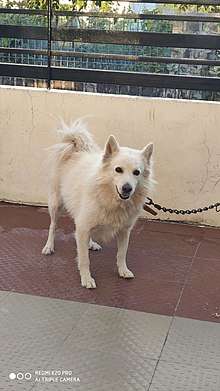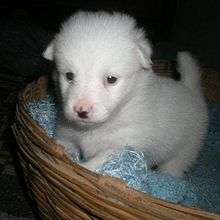Indian Spitz
The Indian Spitz is a spitz-type dog breed belonging to the utility group. The Indian Spitz is a domestic dog and friendly pet. There are varying standards around the world as to the ideal size of the breed, but they are always larger than their smaller cousins, the Pomeranian.[1]
| Indian Spitz | |||||||||||||||||||||||||||||
|---|---|---|---|---|---|---|---|---|---|---|---|---|---|---|---|---|---|---|---|---|---|---|---|---|---|---|---|---|---|
 | |||||||||||||||||||||||||||||
| Origin | India | ||||||||||||||||||||||||||||
| |||||||||||||||||||||||||||||
| Dog (domestic dog) | |||||||||||||||||||||||||||||
The Indian Spitz was one of the most popular dogs in India in the 1980s and the 1990s when India's import rules made it very difficult to import dogs of other breeds.[2]
The Indian Spitz is often called "Indian Pomeranian", though the two breeds are very different. The confusion arises from the fact that both breeds belong to the Spitz family, along with the Pomeranian, Elk-Hound, German Spitz, Samoyed Dogs, Finnish Spitz, and Japanese Spitz, among others.
History
They were first introduced by the occupying British during the 19th century and thought to have descended from the German Spitz. After years of breeding, they were able to create a variety species that could cope with the heat of the Indian summers and retained the intelligence and adaptability of the German breed. Resembling a Samoyed and Pomeranian, they were well suited to the Indian climatic conditions and quickly became popular.
The Indian Spitz is especially prized for its intelligence, which is considered among the highest of the Indian dog breeds. In particular, they are considered to be highly empathetic and able to tell the intentions of a human very well. Indian Spitz are common choices for people who want trick dogs because of their incredibly quick learning abilities.
The Indian Spitz became popular due to restrictive import rules imposed by the Indian Government in the 1980s and 1990s. Foreign imports were very hard to access, and Indians turned to the indigenous and local breeds. The Indian Spitz is similar to the European Spitz, though it has adapted for a warmer climate. They are equally comfortable in small apartments and in large, open houses. However, they do need moderate exercise.
They received glamour in Bollywood. In the film Hum Aapke Hain Kaun (1994), a 6-year-old Indian Spitz named Redo played an important role of 'Tuffy'. Which was the first movie, hosting an Indian Spitz onto screens of India. This dog belonged to the assistant director of the movie Madhukar Sawle. The actress of this film, Madhuri Dixit, later adopted Redo. The dog died in the year 2000 when it was 12 years old.
The Indian Spitz is identified as a separate unique Indian Breed by the Kennel Club of India. It has now been working to establish the Indian Spitz as a separate breed at other Kennel Clubs around the world.
Appearance
The Indian Spitz is a small dog, around 33 cm (13 ins) at the withers, with a soft chest, and a fair tail, pure milky white double coat. Their eyes have very white irises that can be greenish or bluish. This is one of the reasons they have such expressive faces that could led humans rely on looking at each other's irises to tell where we are looking and how we feel about things. Not many animals have this feature but many Indian Spitzes have visible irises.
The original Spitz or Pomeranian was bred for hunting in cold conditions, and their white coloring reflects this. Although the same conditions are not found in India, their coloring is attractive and has remained through the years. Some can be white and brown. Generally, they are white all over.

Pointy fox-like ears that are highly makes this breed especially expressive. Thick fur covers the outside of the ears and covers a lot of the insides as well. This can mean they need extra attention when it comes to care and grooming.
The tail of an Indian Spitz curls over their back and is quite fluffy. Their legs are not very long, being only slightly longer than their bodies, which makes their heads look big and adorable. Indian Spitzes may be one of the easiest dogs to live with. It's why they're arguably the most popular family dog among Indian breeds. They are easily housebroken and trained, so they will learn to do their business outside from an early age. Grooming and exercise is relatively low maintenance, and they are highly adaptable dogs.
They share a common resemblance with the Pomeranian, German Spitz, Samoyed, American Eskimo Dog.
Size variations
Generally Indian Spitzes are divided into two categories, the Smaller Indian Spitz or Lesser Indian Spitz (Roughly 5–7 kg [11–15 lb] in weight and 22–25 cm [8 1⁄2–10 in] at the withers) and the Bigger Indian Spitz or Greater Indian Spitz (Roughly 12–20 kg (26–44 lb) in weight and 35–45 cm (14–17 1⁄2 in) at the withers).
The Indian Spitz is generally milky white but can also be found in solid colours like brown and sometimes (very rarely) a hybrid of black and white similar to the Dalmatian.
Life Span
Most have a lifespan between 10 and 14 years; however some have been known to live up to 16 years of age.
Care
Indian Spitz is an extremely bright and active dog breed. It is adaptable to living in a small houses, but it can also thrive in a large farmhouse with equal ease. It is also counted among the most intelligent dog breeds. It can easily learn various tricks in less than the average time, and has a unique ability to understand human intentions.
Grooming
They are a breed that likes to keep themselves clean but they need regular brushing to keep their long coats in good condition. Their bath schedules can depend from twice a month to once a month considering their fur can easily dry out if bathed too often.
Shedding is a problem with Indian Spitz as their European heritage means they get rid of their winter coat all over your furniture. Their coats are double layered, so make sure you have a double-row brush so you can get to the thick undercoat.
Differences between the Pomeranian and Indian Spitz
Indian Spitz often gets mistaken for a Pomeranian, a cousin Spitz from northern Poland. However, they are quite distinct: the Indian Spitz has a much shorter coat and is bigger. They share a lot of physical characteristics because they are very closely related, being only a few hundred years apart in lineage. A Pomeranian has rounded ears, a flatter face, weighs less (shouldn't exceed 3-4 kg), and has more thicker coat. Other than those minor differences, they are somehow identical although they are completely different from each other. Indian Spitz is bigger and weighs more compared to Pomeranian. Sadly in India people refer to the Spitz as a Pomeranian. Some of the basic differences can be illustrated as follows:
- The Pomeranian is a toy breed. It is much lighter than even a Lesser Indian Spitz, both in height and weight, which typically weighs less than 10 pounds and is rarely over 12 inches in height.
- The Pomeranian has a much flatter face than an Indian Spitz, which has a more conical snout.
- The coat of a Pomeranian is generally much denser and thicker. It is often difficult to see individual hairs. However, an Indian Spitz's coat is much less dense and it is much easier to see the individual hair follicles.
- The Pomeranian's ears are generally not as pointed or elongated as that of an Indian Spitz.
References
- "Difference between Spitz and Pomeranian - An Insight". DogSpot. Retrieved 2020-05-19.
- "Breeds of dog in India". www.bihartimes.in. Retrieved 14 March 2019.
External links
| Wikimedia Commons has media related to Indian Spitz. |